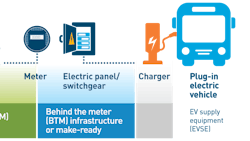PG&E creates tool for fleets to weigh costs of switching to EVs
Pacific Gas and Electric Company (PG&E) created an online tool to help fleets considering transitioning to electric vehicles (EVs) to go with the utility’s EV Fleet program, which helps fleet customers build the infrastructure needed to transition from diesel to battery-electric trucks.
PG&E’s EV Fleet Savings Calculator was created for business and public agencies running medium- and heavy-duty fleet vehicles to explore EV investment estimates based on fleet sizes, infrastructure, budget and other factors.
According to the California Air Resources Board (CARB), transportation is the single largest source of climate-related pollution in California, contributing to 41% of greenhouse-gas emissions across the state. CARB is developing regulations to mandate all intrastate operations of medium- and heavy-duty vehicles be 100% zero-emission by 2045 “where feasible,” with the mandate going into effect by 2035 for drayage trucks.
“Expanding the use of electric vehicles is essential for California to achieve its bold climate and clean-air goals,” said Bill Smith, PG&E’s interim CEO. “PG&E has been an active partner in helping make EVs an option for millions of Californians, including for our business and public agency customers who are transitioning their fleets to electric vehicles. Reducing vehicle emissions is good for our state and good for the environment in which we all live."
Today, approximately 303,000 EVs are registered in PG&E’s service area – roughly one in every five EVs in the nation. PG&E, which is the primary power utility that serves northern California, has made its own commitment to further electrify its fleet by 2030 — including 100% of its light-duty fleet, 10% of its medium-duty fleet and 5% of its heavy-duty fleet.
Along with the EV Fleet Savings Calculator, PG&E offers customers rate options and EV charging infrastructure programs. The calculator tool uses information based on PG&E’s new Business EV Rate, which allows business and public agency customers to evaluate their fleet plans by analyzing how much they can save by switching to EVs.
The tool helps customers understand the critical total cost of ownership factors, including incentives, energy costs, infrastructure considerations and participation in California’s statewide Low Carbon Fuel Standard (LCFS). After customers input information on vehicles and usage, the tool makes recommendations for charging infrastructure, charging schedule based on fleet needs, how much they can save on fuel costs, the revenue they could generate from LCFS, and estimated reductions in greenhouse-gas emissions.
PG&E’s Business EV Rate supports charging needs for fleets and public locations. On average, EV customers on the new rate can save up to 40% on charging costs compared to previous rate options, according to the utility. However, actual bill impacts will vary for each customer depending on the types of vehicles and charging patterns.
Customers on PG&E’s Business EV Rate can sign up for a subscription charge, which allows them to choose the amount of kilowatt power they need for their charging stations, similar to selecting a data plan for a phone bill. This subscription charge can be lower than the current rate options and allows customers to have simpler, more consistent monthly costs, according to PG&E.
On the Business EV Rate, customers pay for the electricity used by the EV chargers and the monthly subscription charge. Customers can also adjust their subscription levels up or down to meet their changing needs for EV charging.
PG&E’s EV Fleet program
PG&E’s EV Fleet program helps customers with medium-duty, heavy-duty and off-road fleets begin to transition their fleet vehicles to clean electricity to save money, eliminate tailpipe emissions and simplify maintenance. By 2024, the program aims to help more than 700 organizations deploy more than 6,500 EVs across numerous medium- and heavy-duty fleet categories.
Through the EV Fleet program, PG&E builds the electrical infrastructure for customers’ medium- to heavy-duty EVs from the utility pole (electric service) to the customer meter or to the charger, depending on which ownership option the customer chooses. PG&E comprehensively helps customers across all facets of EV charging, including available incentives and rebates, site design and permitting, construction and activation, and maintenance and upgrades.
About the Author
FleetOwner Staff
Our Editorial Team
Kevin Jones, Editorial Director, Commercial Vehicle Group
Josh Fisher, Editor-in-Chief
Jade Brasher, Senior Editor
Jeremy Wolfe, Editor
Jenna Hume, Digital Editor
Eric Van Egeren, Art Director
